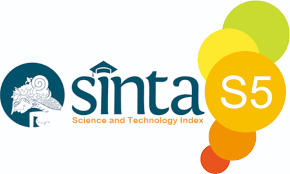THE CREATION OF SHORT STORY CHARACTER THROUGH WAYANG GOLEK PUPPET SHOW
DOI:
https://doi.org/10.22460/jler.v4i2.6412Keywords:
Short stories, Wayang Golek, CharacterAbstract
Writing short text requires the ability to cultivate the imagination to pour it into writing that is animate and interesting. In fact, creating imagination is not easy, therefore we need media that can help the process of getting ideas and generating students' interest in learning the short text. This research will use video wayang golek as a means to create characters according to the characters in the wayang golek play. The essence of this research is the achievement of students in determining interesting wayang golek figures and made according to personal imagination by imitating directly, modifying, or even changing the whole according to personal desires. The characters in wayang stories that are considered regionally will be packaged to be more interesting and modern according to the imagination a teenager. Data were analyzed using descriptive qualitative conducted in three stages, reading short stories, analyzing character characters, and describing character characters created from wayang golek. The results of the analysis show that the use of wayang golek media can improve students' abilities in creating character characters so as to create a short story text that has its own attractiveness, inherit adolescent imagination and thought, and can preserve the cultural richness of the West Java region. This wayang golek can also be used by teachers as an effective medium in learning. Students will find interesting parts and create their own character so as to create a process of independence in learning. and describe the characters created by wayang golek. The results of the analysis show that the use of wayang golek media can improve students' abilities in creating character characters so as to create a short story text that has its own attractiveness, inherit adolescent imagination and thought, and can preserve the cultural richness of the West Java region. This wayang golek can also be used by teachers as an effective medium in learning. Students will find interesting parts and create their own character so as to create a process of independence in learning. and describe the characters created by wayang golek. The results of the analysis show that the use of wayang golek media can improve students' abilities in creating character characters so as to create a short story text that has its own attractiveness, inherit adolescent imagination and thought, and can preserve the cultural richness of the West Java region. This wayang golek can also be used by teachers as an effective medium in learning. Students will find interesting parts and create their own character so as to create a process of independence in learning. inherit the imagination and thoughts of adolescents, and can preserve the cultural wealth of the West Java region. This wayang golek can also be used by teachers as an effective medium in learning. Students will find interesting parts and create their own character so as to create a process of independence in learning. inherit the imagination and thoughts of adolescents, and can preserve the cultural richness of the area of West Java. This wayang golek can also be used by teachers as an effective medium in learning. Students will find interesting parts and create their own character so as to create a process of independence in learning.
References
Ceylan, NO (2016). Using Short Stories in Reading Skills Class. Procedia - Social and Behavioral Sciences, 232 (April), 311–315. https://doi.org/10.1016/j.sbspro.2016.10.027.
Ghazanfari, M., Ziaee, M., & Sharifianfar, E. (2014). The Impact of Illustrations on Recall of Short Stories. Procedia - Social and Behavioral Sciences, 98, 572–579. https://doi.org/10.1016/j.sbspro.2014.03.453
Herdiana. (2013). Short Story Writing Lessons Using Video Media of Sand Painting through Transformation Techniques. Journal of Chemical Information and Modeling, 53 (9), 1689–1699. https://doi.org/10.1017/CBO9781107415324.004
Kristanto, D. (2016). Illustration of Idola Characters in Class XI Students of SMA Negeri 1 Wadaslintang. (2).
Nurfatoni, S., Tocharman, M., Sobandi, B., Education, J., Rupa, S., & Language, F. (2013). Basic School Level (Analytical Descriptive Study of the Characteristics of the Drawing Characteristics of Class 3 Students at SDN 01 Gandrungmangu, Cilacap Regency). 1, 1–15.
Nurgiyantoro, B. (2001). Smart Learning Indonesian. Jakarta: Earth Literacy.
Pradopo, RD (2012). Literary Research Methodology. Hanindita Graha Widya.
Sabunga, B., Budimansyah, D., & Sauri, S. (2016). Character Values in Performance. Sosioreligi Journal, 14 (1), 1–13.
Sobari, T. (2018). Ceylan, NO (2016). Using Short Stories in Reading Skills Class. Procedia - Social and Behavioral Sciences, 232 (April), 311–315. https://doi.org/10.1016/j.sbspro.2016.10.027.
Ghazanfari, M., Ziaee, M., & Sharifianfar, E. (2014). The Impact of Illustrations on Recall of Short Stories. Procedia - Social and Behavioral Sciences, 98, 572–579. https://doi.org/10.1016/j.sbspro.2014.03.453
Herdiana. (2013). Short Story Writing Lessons Using Video Media of Sand Painting through Transformation Techniques. Journal of Chemical Information and Modeling, 53 (9), 1689–1699. https://doi.org/10.1017/CBO9781107415324.004
Kristanto, D. (2016). Illustration of Idola Characters in Class XI Students of SMA Negeri 1 Wadaslintang. (2).
Nurfatoni, S., Tocharman, M., Sobandi, B., Education, J., Rupa, S., & Language, F. (2013). Basic School Level (Analytical Descriptive Study of the Characteristics of the Drawing Characteristics of Class 3 Students at SDN 01 Gandrungmangu, Cilacap Regency). 1, 1–15.
Nurgiyantoro, B. (2001). Smart Learning Indonesian. Jakarta: Earth Literacy.
Pradopo, RD (2012). Literary Research Methodology. Hanindita Graha Widya.
Sabunga, B., Budimansyah, D., & Sauri, S. (2016). Character Values in Performance. Sosioreligi Journal, 14 (1), 1–13.
Sobari, T. (2018). Application of the Method of Binding Meanings in Teaching Short Story Writing Students of IKIP Siliwangi Bandung. Semantics, 7 (1), 1–13. https://doi.org/10.22460/semantik.vXiX.XXX
Sugiyono. (2013). Educational Research Methods: Quantitative, Qualitative, and RnD Approaches.
Sutardi, K.. (2012). Creative Literary Writing. Yogyakarta: Graha Science.
Tarigan, HG (2013). Writing as a Language Skill. Bandung: Space.
of the Method of Binding Meanings in Teaching Short Story Writing Students of IKIP Siliwangi Bandung. Semantics, 7 (1), 1–13. https://doi.org/10.22460/semantik.vXiX.XXX
Sugiyono. (2013). Educational Research Methods: Quantitative, Qualitative, and RnD Approaches.
Sutardi, K.. (2012). Creative Literary Writing. Yogyakarta: Graha Science.
Tarigan, HG (2013). Writing as a Language Skill. Bandung: Space.






